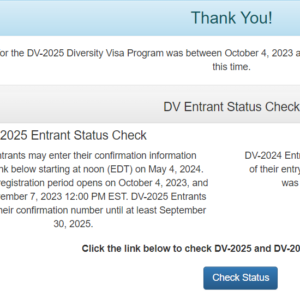Low and High Case Numbers
VERY IMPORTANT
A MUST-READ FOR DV 2024 (and now DV 2025) APPLICANTS:
I wish to clarify that this article was written in 2022, and that the ‘norms’ presented in it were derived at after interpolation of case number data from DV programs before DV 2024. As such, the contents of the article do not apply in the case of the DV 2024 Program, and may not in subsequent DV Programs.
For the DV 2024 Program, I have provided more explanation in this article.
AND FOR DV 2025: It is still too early to draw conclusions on the prospects of case numbers as there isn’t sufficient data to allow that for the time being.
When the prospects of DV 2025 case numbers become clearer, I shall publish an article addressing the issue – as I did for DV 2024. Look out for that article!
(This article however provides invaluable insight into the concept of high and low case numbers in the Diversity Visa program).
Thank you.
The Basis for Scheduling
A case number is the basis for when a Diversity Visa case is to be scheduled for interview. As such, its position in a region is a major preoccupation for most applicants.
I’m therefore writing this article to provide applicants – especially those who are unaware – with a kind of estimate of what could be considered low, medium or high case number in their region, as well as when different case numbers can expect to be interviewed during the Program year.
[CLICK HERE to jump to Case Number Tables] or continue reading the article below.
Interviews in each region begin with the lowest case numbers and progress to high ones as the fiscal year goes on. This gives cases with low case number a higher chance of being interviewed than those with high ones.
Concerning the tables below, let me include the following notes:
NOTE:
1. The below are estimates intended to serve as ‘signposts’ and should be considered as such.
2. A position and a ‘likely’ time of interview have been assigned to each case number range established. This concept is not official. It is however based on the fact that low case numbers have less risk than higher ones.
3. The details shown for each case number range (which are subject to adjustment) are approximate values based on interpolations from recent years. As such, some case numbers may fall in a neighboring range in reality.
That being indicated, the following tables show – by region – low, average and high case numbers, and when cases in each range can look forward to be interviewed.
IMPORTANT: Under normal circumstances, interview notifications are sent out to applicants during the second month (5 – 10 weeks) before their interview.
It must be also be noted that the highest case numbers in each region may never be scheduled for interview as the Program year may come to an end or visas run out before scheduling reaches them.
AFRICA
| Case Number | Classification | Chances | Likely Interview Time |
|---|---|---|---|
| Below 10000 | Low | Very High | October – January |
| 10000 – Below 20000 | Relatively Low | High | January – March |
| 20000 – Below 30000 | Average | Good | March – June |
|
30000 – Below 40000 |
Relatively High |
Fair |
June – August or when |
| 40000 & Above | High | Low | Aug. – Sept. or when AF goes current; Note: may not get interviewed |
Except:
EGYPT
| Case Number | Classification | Chances | Likely Interview Time |
|---|---|---|---|
| Below 4000 | Low | Very High | October – December |
| 4000 – Below 8000 | Relatively Low | High | January – March |
| 8000 – Below 12000 | Average | Good | March – May |
|
12000 – Below 15000 |
Relatively High |
Fair |
May – July or when |
| 15000 & Above | High | Low | Aug. – Sept. or when Egypt goes current; Note: may not get interviewed |
AMERICA, NORTH (THE BAHAMAS)
| Case Number | Classification | Chances | Likely Interview Time |
|---|---|---|---|
| Below 5 | Low | Very High | October – January |
| 5 & 6 | Relatively Low | Very High | January – March |
| 7 & 8 | Average | High | March – June |
|
9 & 10 |
Relatively High |
Good |
June – August or when |
| Above 10 | High | Fair | Aug. – Sept. or when NA goes current; Note: may not get interviewed |
AMERICA, SOUTH and the CARIBBEAN
| Case Number | Classification | Chances | Likely Interview Time |
|---|---|---|---|
| Below 500 | Low | Very High | October – January |
| 500 – Below 750 | Relatively Low | High | January – March |
| 750 – Below 1000 | Average | Good | April – May |
|
1000 – Below 1500 |
Relatively High |
Fair |
June – July or when |
| 1500 & Above | High | Low | Aug. – Sept. or when SA goes current; Note: may not get interviewed |
ASIA
| Case Number | Classification | Chances | Likely Interview Time |
|---|---|---|---|
| Below 3500 | Low | Very High | October – January |
| 3500 – Below 5000 | Relatively Low | High | January – March |
| 5000 – Below 7500 | Average | Good | March – June |
|
7500 – 10000 |
Relatively High |
Fair |
June – August or when |
| Above 10000 | High | Low | Aug. – Sept. or when AS goes current; Note: may not get interviewed |
Except:
IRAN
| Case Number | Classification | Chances | Likely Interview Time |
|---|---|---|---|
| Below 1000 | Low | Very High | October – November |
| 1000 – Below 2500 | Relatively Low | High | November – December |
| 2500 – Below 5000 | Average | Good | December – March |
|
5000 – Below 6500 |
Relatively High |
Fair |
March – June or when |
| 6500 & Above | High | Low | June – Sept. or when Iran goes current; Note: may not get interviewed |
NEPAL
| Case Number | Classification | Chances | Likely Interview Time |
|---|---|---|---|
| Below 1000 | Low | Very High | October – November |
| 1000 – Below 2000 | Relatively Low | High | November – December |
| 2000 – Below 4000 | Average | Good | December – March |
|
4000 – Below 6000 |
Relatively High |
Fair |
March – June or when |
| Above 6000 | High | Low | June – Sept. or when Nepal goes current; Note: may not get interviewed |
EUROPE
| Case Number | Classification | Chances | Likely Interview Time |
|---|---|---|---|
| Below 7500 | Low | Very High | October – January |
| 7500 – Below 10000 | Relatively Low | High | January – March |
| 10000 – Below 18000 | Average | Good | March – June |
|
18000 – Below 25000 |
Relatively High |
Fair |
June – August or when |
| 25000 & Above | High | Low | Aug. – Sept. or when EU goes current; Note: may not get interviewed |
OCEANIA
| Case Number | Classification | Chances | Likely Interview Time |
|---|---|---|---|
| Below 400 | Low | Very High | October – January |
| 400 – Below 600 | Relatively Low | High | January – March |
| 600 – Below 950 | Average | Good | March – June |
|
950 – Below 1400 |
Relatively High |
Fair |
June – August or when |
| 1400 & Above | High | Low | Aug. – Sept. or when OC goes current; Note: may not get interviewed |
FINAL NOTE
As the above is intended to only serve as ‘signposts’, be sure to regularly follow the State Department’s Visa Bulletin to know the actual monthly cut-offs that will apply in your region.
SUGGESTED: For indepth explanation regarding case numbers, read this article.



So as per your chart i have very low chance of getting called for interview coz i am from Oceania with case no 1650
Hi: Kindly refer to the note at the beginning of the article for relevant answer to your question.
I won the dv 2024 from Liberia with the case number of 87043 is there a chance for interview.
Yes, there’s a chance for interview.
Hello
My case number is EU342**, which i not too high not to low?
However I live in Taiwan and set Taipei embassy as an interview embassy, does it increase the chance my case could be processed earlier or it doesn’t have anything to do with the embassy location?
PROCESSING of cases is independent of the embassy location.
Did you got an interview??